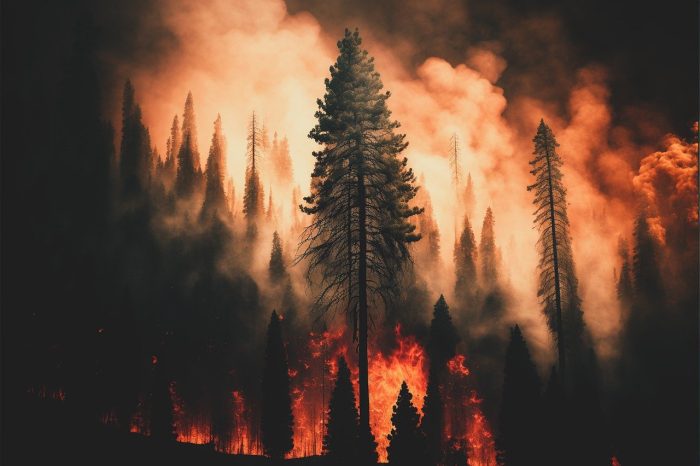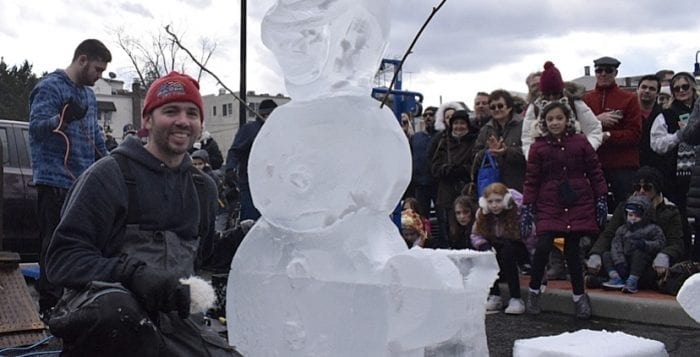Save the date! Town of Brookhaven Supervisor Dan Panico along with Councilmember Jonathan Kornreich will host a Battery Energy Storage Systems (BESS) Community Forum at Suffolk County Community College’s Ammerman Campus, 533 College Road, Selden on Tuesday, Jan 21 in the Shea Theater, Islip Arts Building, from 7 p.m. to 9 p.m.
California fire particles detected on Long Island
By Daniel Dunaief
Small particles from the raging wildfires in Los Angeles that have killed residents, destroyed homes and businesses and have caused massive evacuations have crossed the country, reaching Long Island.

“Our instruments are picking up evidence detecting California wildfires already,” said Arthur Sedlacek, III, Aerosol Processes Group leader in the Environmental & Climate Sciences Department at Brookhaven National Laboratory. “What’s happening 3,000 miles away can impact us” just like the fires in Quebec did.
The amount and concentration of particles on Long Island from these particles doesn’t present a health risk to many people in the population.
“For those who are sensitive to inhalation irritation, it opens up the possibility” of developing breathing difficulties or adding particles that could irritate their lungs, Sedlacek continued.
To be sure, the majority of people on Long Island and the east coast may not react to levels of particulates that are considerably lower than for residents of Los Angeles and the surrounding areas.
Local doctors suggested that these particles can trigger a range of health problems for those who are closer to the flames and smoke.
“The general rule is the larger the exposure, the greater the effect,” said Dr. Norman Edelman, a pulmonologist at Stony Brook Medicine.
Researchers have shown that the exposure doesn’t have to be especially high to affect health.
‘We more we look, the more we see that lower and lower doses will have negative effects,” said Edelman.
If and when particulates build in the air where patients with lung challenges live, pulmonologists urge residents to take several steps to protect themselves.
First, they can adjust their medication to respond to a greater health threat.
In addition, they can wear a particle mask, which is not an ordinary surgical mask.
Over time, continued exposure to particulates through pollution, wildfires or other emissions may have a cumulative health effect.
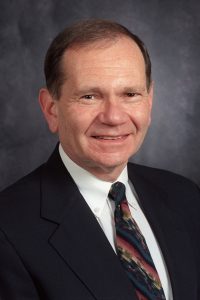
In the South Bronx, about 40 percent of children have asthma, compared with closer to 10 percent for the rest of the country. While genetics may contribute to that level, “we believe it’s because they are exposed to intense, continuous air pollution from motor vehicle traffic,” said Edelman, as cars and trucks on the Cross Bronx Expressway pollute the air in nearby neighborhoods.
The cumulative effect on people with existing disease is more pronounced.
Even when exposure and a lung reaction end, people “don’t quite come back to where [they] started,” said Edelman. “They lose a little bit of lung function.”
Particulates not only can cause damage for people who have chronic lung issues, like asthma or chronic obstructive pulmonary disease, but can also cause problems for people who have other medical challenges.
“We do know that this kind of pollution generates heart attacks in people with heart disease,” said Edelman. “That’s relatively new knowledge.”
A heating cycle
The ongoing fires, which started on Jan. 7 and were exacerbated by the Santa Ana winds of 70 miles per hour, have been consuming everything in their path, throwing a range of particles into the air.
These can include organic particles, black particles, which is akin to something that comes out of the tailpipe of a school bus and all sorts of particles in between, Sedlacek said.
These particles can form condensation nuclei for clouds and water droplets and they can absorb solar radiation and light.
Heating the upper troposphere with particles that absorb radiation alters the typical convention dynamic, in which hot air usually rises and cool air sinks
These changes in convection, which can occur with each of these major wildfires, can affect local air currents and even, in the longer term, broader air circulation patterns.
Sedlacek suggested that some areas in California and in the west may have reduced the use of controlled burns, in part because of the potential for those fires to blaze out of control.
“With the absence of range management and controlled burns to clear out the understory, you don’t have those natural fire breaks that would otherwise exist,” said Sedlacek. “In my opinion, you have to do controlled burns.”
Wildfires, Sedlacek added, are a “natural part of the ecosystem,” returning nutrients that might otherwise be inaccessible to the soil.
Without wildfires or controlled burns, areas can have a build up of understory that grows over the course of decades and that are potentially more dangerous amid a warming planet caused by climate change.
Indeed, recent reports from the Copernicus Climate Change Service indicate that 2024 was the hottest year on record, with temperatures reaching 1.6 degrees Celsius above the average in pre-industrial revolution levels. The Paris Climate Accord aimed to keep the increase from the late 19th century to well below 2 degrees, with an emphasis on a 1.5 degree limit.
The fires themselves have become a part of the climate change cycle, contributing particulates and greenhouse gases to processes that have made each of these events that much worse.
“These fires generate greenhouse gases and aerosol particles in the atmosphere that can then further increase or contribute to a warming of the globe,” said Sedlacek. “We have this positive feedback loop.”
In the climate change community, researchers discuss feedback, which can be positive, pushing an event or trend further in the same direction, or negative, which alters a process.
Sedlacek likens this to driving in a car that’s heading to the right towards the shoulder. In negative feedback, a driver steers the car in the other direction while positive feedback pushes the car further from the road.
Wildfires, which contribute and exacerbate global warming, can push the car towards a ditch, Sedlacek said.
Some scientists have urged efforts to engage in geoengineering, in which researchers propose blocking the sun, which would cause negative feedback.
“That might be a great idea on paper, but I don’t know if you want to play chemistry on a global scale,” said Sedlacek. Considering efforts to reduce solar radiation has merit, he suggested, but requires a closer analysis under controlled circumstances to understand it.
“I sincerely hope that the powers that be will appreciate the importance of what we do to understand” these processes, Sedlacek said. Understanding the models researchers have created can inform decisions.
Letters to the Editor: January 16, 2025
Cancer Prevention in Action
We have the power to prevent cervical cancer.
January is Cervical Cancer Awareness Month. Over 11,500 people in the U.S. will be diagnosed with cervical cancer in 2025. However, almost all of these cases are preventable. Through cervical cancer screening and Human Papillomavirus (HPV) vaccination, we have the power to prevent cervical cancer.
Stony Brook Cancer Center’s Cancer Prevention in Action (CPiA) program is here to help you and your loved ones reduce your risk of cervical cancer with these prevention tips:
Schedule your screening: Cervical cancer screening tests can find cells that lead to cancer so that they can be removed before cancer grows. In addition to the Pap test, testing for HPV cells within the cervix is now recommended as a primary screening method. The American Cancer Society recommends routine cervical cancer screening for people with a cervix starting at age 25 through 65.
Get vaccinated: Almost all cervical cancers are caused by HPV. The HPV vaccine prevents cervical, and five other types of cancer, by preventing the virus that causes them. HPV vaccination is recommended for children of all genders beginning at age 9. It is also recommended for adults not vaccinated in childhood through age 26. With over 135 million doses administered in the United States in the last two decades, the HPV vaccine has proven to be extremely safe and effective in preventing HPV cancers.
Raise awareness: Cervical cancer is preventable. Raise awareness amongst your family, friends, and community that cervical cancer can be prevented through vaccination and screening. Consider organizing an awareness event or education session for your workplace, organization, PTA, or other community setting with Stony Brook Cancer Center’s CPiA program.
The CPiA program works to increase HPV vaccination and reduce cancer rates on Long Island. CPiA educates people of all ages in a variety of community settings about cancer prevention and healthy living.
To learn more about cervical cancer prevention or to get involved with CPiA at Stony Brook Cancer Center, go to www.takeactionagainstcancer.com or contact us at 631-444-4263 or at [email protected].
Stony Brook Cancer Center’s Cancer Prevention in Action
The implications of the R-word
Dear anyone who uses the R-word,
As the father of a young man with Down syndrome and the leader of a business where more than half of our colleagues have differing abilities, I feel compelled to address leaders who have used the R-word.
There is no denying your place in the world. That power and influence comes with a greater sense of obligation. Your statements matter. Your words matter. There was a time when using that term was acceptable. Yet in those times that word dehumanized people with differing abilities, people like my son John. That term denied people a sense of dignity and a place in our society.
That word gained prominence during a period when people with intellectual development disabilities were often shunned, relegated to institutions, denied an education, barred from employment and rejected by society. They were treated as sub-human.
Thankfully, times have changed. People with differing abilities have become full members of our society, many playing a prominent role. My son John is an entrepreneur like you and has co-founded the world’s largest sock store. And John is only one of a growing number of entrepreneurs, business leaders, artists, actors, athletes, and political activists with a differing ability. At our business, more than half our colleagues have a differing ability, and we succeed because of the excellent work they do.
People with differing abilities have been patient waiting for the rest of us to catch up, to recognize their strengths and ability to contribute to our society. We need them. We need them in our schools, our businesses and our communities. Terms like the R-word have faded away as people learn how much it hurts, see the negative impact it has and, most importantly, how wrong-headed the description is.
I urge you to consider how your words and actions might advance this progress rather than hinder it. Language has the power to uplift or harm, to unite or divide. You have the opportunity to champion a vision of inclusion, where every person—regardless of their abilities—is treated with respect and celebrated for their unique gifts.
I invite you to visit our business, John’s Crazy Socks. Come meet John and our colleagues with differing abilities. Come see first-hand the potential and humanity that outdated stereotypes obscure. As someone who has defied expectations and pushed boundaries, you have the ability to model a future that leaves no one behind.
This moment can be a turning point. By choosing compassion, understanding, and inclusion, you can inspire others to do the same and help build a world where dignity and opportunity are extended to all.
Will you join us in this mission? Your voice could be a powerful catalyst for change.
Regards,
Mark X. Cronin
Father, Advocate, and Co-Founder of John’s Crazy Socks
More details needed about lithium-ion batteries
We have under consideration at least two large lithium-ion battery installations in our local neighborhoods. One, according to Ira Costell, the president of the Port Jefferson Station/Terryville Civic Association, will be an 8-10 MW system, to be provided by New Leaf Energy. The other, also according to Mr. Costell, will be a mammoth 350 MW facility from Savion, although the Renewables Now website lists this as having a rated power of only 110 MW.
In any case, if we are to understand the capabilities and limitations of these installations, a more complete definition of their energy storage capabilities is required.
This must include not only a power rating, e.g., 10 MW, but also the length of time for which the power can be delivered by the battery. For example, if a battery can provide 10 MW of power for 5 hours, its energy rating is 50 MWh (megawatt hours). Thus, if we know the energy rating of a battery, and we also know the load power, we can calculate the time for which the power will be supplied. For example, a 50 MWh battery can provide 1 MW for 50 hours, or 5 MW for 10 hours, and so forth. At the end of these periods, the battery becomes fully discharged, and must be recharged for further use.
The energy capacities of these batteries are important, because of the intermittent and unpredictable nature of the mandated future energy sources, which will be solar arrays and windmills. When these sources are generating their full rated power, they will be both powering the commercial customers and charging the batteries. As an example, let us assume we have 2,000 houses, each with a load of 1,000 W (1 kW), or 2 MW total. A 50 MWh battery can therefore provide the required power (2 MW) for 25 hours. When the solar/wind power is available, it powers the customer houses and also charges the battery. When the solar/wind input power stops, the load power is provided by the battery, for up to 25 hours. If the input power outage exceeds 25 hours, the 2,000 customers will be without power until the input power becomes available.
The key point is that the energy (MWh) capability of the battery must be sufficient to provide the required power for at least the longest possible down time of the primary power source. If this condition is not met, prolonged power outages and blackouts will be the inevitable result.
If we are to understand and evaluate the capabilities of these proposed battery facilities, it would be most helpful to have New Leaf Energy and Savion provide the energy specifications to us, rather than simply some undefined power numbers, which leave us in the dark with regard to the time for which the power will be available.
George Altemose
Setauket
D. None of the Above: A fourth born prepares to take over the White House from an eldest

By Daniel Dunaief

Here we are, teetering on the precipice of the transition from Joseph Biden back to Donald Trump at the White House.
What better time than now to ponder some random facts, such as birth order, about the presidency? I used a Potus Presidential Facts website that included siblings and half-siblings for the first part of this column and a host of other websites, including Wikipedia for the second part.
For starters, none of the men (it’s a men’s only club so far) who were the commander in chief were only children. Three presidents, meanwhile, had only one sibling. That list includes Calvin Coolidge, Franklin D. Roosevelt and Ronald Reagan.
Now, I figured that more presidents were first children than subsequent children, in part because first children often rule the roost, as primogeniture would suggest. But I was wrong.
Yes, first children are well represented, as 11 presidents were the oldest in their families.
First born children who would go on to become president started with John Adams and James Madison and included Lyndon Baines Johnson, Gerald Ford, Jimmy Carter, George W. Bush (43) and the soon-to be ex-president Joseph Biden, among others.
Second children, however, constituted the greatest number of presidents. After a lifetime of being described as number two, I now realize what a compliment such a designation is, at least in terms of presidential history, where number two is number one.
Starting with James Monroe, that list includes such luminaries as Abraham Lincoln, Theodore Roosevelt, Franklin D. Roosevelt, Harry Truman, John F. Kennedy and, well, Richard Nixon. Okay, so, Nixon didn’t exactly cover himself in glory, resigning in disgrace after the Watergate Scandal, but he doesn’t bring all second children down.
First and second children constitute 56 percent of the presidents.
Going to the presidents who had numerous older siblings, the three presidents who were born seventh all shared the same first name: William. The seventh born commanders in chief were William Henry Harrison, William McKinley and William Howard Taft. If history is any guide, that means a seventh born William, assuming somehow your parents didn’t choose the name for any of your older siblings, has a path to the presidency.
Four presidents were born sixth, starting with George Washington. Joining the first president in the number six club are Martin Van Buren, John Tyler and Franklin Pierce.
The fifth born list only has three entrants: James Garfield, Chester A. Arthur and Grover Cleveland, who shares the distinction of being the only president elected in two non-consecutive terms with Trump.
Fourth born presidents also have three members, starting with Zachary Taylor, continuing with Rutherford B. Hayes and going to Trump.
And, finally, seven presidents were born third in their families. The list started with Thomas Jefferson and included Andrew Jackson, Andrew Johnson, Woodrow Wilson, Dwight D. Eisenhower, Bill Clinton and Barack Obama.
Now, seven presidents were the youngest child, including Herbert Hoover, Ronald Reagan, Andrew Jackson, Andrew Johnson, Rutherford B. Hayes, James A. Garfield and William Henry Harrison.
On average, presidents had a little over five siblings. Biden had three siblings and Trump had four, making him the penultimate child.
James Madison, who served as the fourth president, had the most siblings, at 11.
While similar lists for first ladies are harder to find (at least for me), I did find some interesting factoids about a few first ladies.
During the war of 1812, Dolley Madison, whose first name originally had an “e” then didn’t in historical records and then did again as of 1958, rescued artifacts from the White House before the British burned it down. Frances Cleveland, meanwhile, was the youngest first lady and the only one who got married in the White House. At 21, she wed 49-year old Grover Cleveland.
Helen Taft was the first to ride with her husband in the inaugural parade and the first to ensure staff were treated equally in the White House. She planted the first of 3,000 cherry trees Tokyo had sent as a gift, helping to establish cherry trees as a staple along the Potomac river.
As for pets, Trump, James K. Polk and Andrew Johnson were the only White House occupants who didn’t have pets, according to Wikipedia. I’m guessing that some of the Secret Service members bitten by Biden’s dog Commander would have preferred that the incumbent didn’t own a canine.
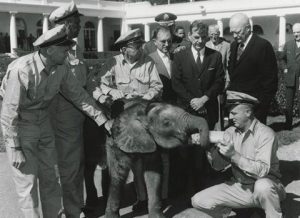 Teddy Roosevelt had numerous pets when he was president, including snakes, dogs, cats, a badger, birds, and guinea pigs.
Teddy Roosevelt had numerous pets when he was president, including snakes, dogs, cats, a badger, birds, and guinea pigs.
Numerous presidents received larger animals that they sent elsewhere. Eisenhower, for example, received a baby Forest Elephant from the French Community of African Republics that he shipped to the National Zoo.
Between You and Me: Gone are the party hats and champagne as reality enters our lives
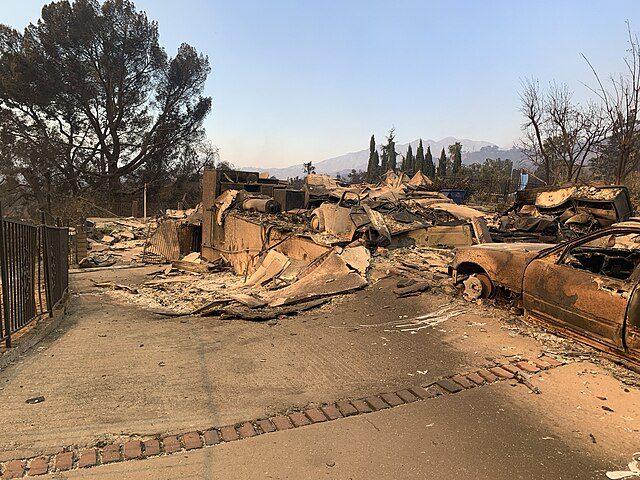
By Leah S. Dunaief

Publisher
It may have started as a new year filled with hope, but this is a difficult week. The terrible fires in Southern California have burned entire neighborhoods to the ground, from mansions to mobile homes. We already know about the displaced and the deaths, but more destruction may yet come. Weather forecasts from the National Weather Service are predicting fierce winds ahead that may drive the fires into new areas.
The end is not in sight.
While this horror is on the other side of the country, it is not remote. Many of us have friends and relatives who live, work, study or are retired there, driving the tragedy right into our midst and into our hearts in a deeply personal way. These are not only abstract numbers of people and homes about which we would feel a humanitarian empathy. These are our people. These are our forests and our lands. The dreadful irony of it all, remembering the 1972 Albert Hammond song, “It Never Rains in Southern California.”
While there was already a serious homeless population for Los Angeles, the newly displaced are trying to figure out what to do next. The lucky ones have relatives or friends with whom they can seek shelter. It may be long weeks, even months before they can return, if their homes miraculously are still standing. What if they are not? Will the insurance companies hold up to enable rebuilding, or will some of them declare bankruptcy, as they have done in similar cataclysmic situations, like the one in the Caribbean Island St. Croix? Can FEMA bear the entire load?
Private citizens can be counted on to respond generously, as we have with virtually every disaster in the world. With such an enormous catastrophe, the entire national economy could take a hit. How will the new administration respond?
Speaking of the government, we have less than a week before the new administration is sworn into office. The change of political parties may in itself contribute to some emotional reaction this week, regardless of one’s party affiliation.
Many Dems are worried, while many members in the GOP are optimistic. There has been much talk of changes to come, from buying Greenland for its exotic minerals to changing the name from the Gulf of Mexico to the Gulf of America. Perhaps more seriously, there may be a tax cut in the future, some change in immigration policy and new tariffs imposed or at least threatened.
Some good news did emerge this week. There may be a truce in Gaza after 15 months of violence, with some hostages to be exchanged for Palestinian prisoners and specific movements of Israeli troops. While the atmosphere surrounding the peace talks remains tense, according to media reports, there now seems some hope.
According to Secretary of State Antony Blinken, the negotiators are only awaiting Hamas’s sign off. Perhaps the imminent changeover of presidents from Biden to Trump in the United States hastened the deal. The governments of Qatar and Egypt have also directly participated in the talks.
Perhaps now the fighting in Ukraine and the fires in Southern California can also be brought to a halt. Then we could return to hope.
Town of Brookhaven rings in the new year with winter recreation programs
The Town of Brookhaven’s Parks & Recreation Department is ringing in the new year with a series of new classes and programs at our various recreation centers. Learn more about what we have to offer and register online today!
Centereach Administration Building
286 Hawkins Road, Centereach
631-451-6112
Indoor Winter Bocce League
Meet and play with different people each week. 2 games per week. individual sign up.
Dates: Tuesdays, January 7, 14, 21, 28, February 4, 18 OR Thursdays, January 9, 16, 23, 30, February 20, 27
Time: 10:00AM – 12:00PM
Fee: $32.00 per person per 6-week session
Click HERE to register online.
Indoor Winter Night Bocce League
4-6 players per team. Each team plays 2 games per day. 12 points or 25 minute rounds.
Dates: Tuesdays, February 18, 25, March 4, 11, 18, 25
Time: 6:00pm-9:00pm
Fee: $185.00 per 6-week session per team
Click HERE to register online.
Henrietta Acampora Recreation Center
39 Montauk Highway
Blue Point, NY 11715
631-451-6163
Yoga
Yoga that meets you where you are today. This class includes standing postures, strengthening exercises on the mat, seated stretches and guided relaxation. Our practice supports strength, agility, flexibility, and balance, while reducing stress and having fun. Please bring a yoga mat, yoga blocks or rolled towel.
Dates: Mondays, February 3, 10, 24, March 10, 17, 24
Time: 1:00pm – 2:00pm
Fee: $47.00 per 6-week session
Click HERE to register online.
Watercolor Painting Class
Meet fellow artists, try a new hobby or work on an old project. Bring your own material and work in a relaxed environment. Instructor will give demonstrations along with group and individual guidance.
Dates: Tuesdays, February 4, 11, 18, 25, March 4, 11, 18, 25
Time: 10:00am – 12:00pm
Fee: $47.00 per 8-week session
Click HERE to register online.
Copper Repousse’ Decorative Metal Workshop (18+)
Create a design in relief (a sculptural technique where figures or scenes are carved into a flat background, creating the illusion that the sculpted material has been raised above the background) using copper sheet and embossing stylus tools. Students must bring your own simple design drawn in a coloring book style or use a class supplied design.
Dates: Tuesdays, February 4, 11, 18, 25
Time: 12:00PM – 2:00PM
Fee: $25.00 per 4 week session PLUS $7.00 material fee paid to instructor the first day of class.
Click HERE to register online.
Adult Art Class
Meet fellow artists, try a new hobby or work on an old project. Bring your own material and work in a relaxed environment. Instructor will give demonstrations along with group and individual guidance.
Dates: Thursdays, February 6, 13, 20, 27, March 6, 13, 20, 27
Time: 10:30am – 12:30pm
Fee: $47.00 per 8-week session
Click HERE to register online.
Sprouts & Friends Baby Class (Ages 3-12 months)
Join Sprouts & Friends for a fun, safe and creative way to learn to move through music and release energy. Our mission is to create joy while helping your little ones grow, learn, develop, and explore through playful activities. Please bring a blanket for baby to lay on. Non-walkers only.
Dates: Fridays, February 7, 14, 28, March 7, 14, 21, 28, April 4
Time: 1:00pm – 1:45pm
Fee: $57.00 per 8-week session
Click HERE to register online.
Country Line Dancing
These classes welcome advanced beginner and intermediate dancers (improver level). Classes will teach students popular line dances being done across the country while having fun and getting exercise as well.
Dates: Mondays, March 31, April 7, 14, 21, 28, May 5, 12, 19
Time: 2:30pm – 4:00pm
Fee: $57.00 per 8-week session
Click HERE to register online.
New Village Recreation Center
20 Wireless Road
Centereach, NY 11720
631-451-5307
Zumba
This high-energy cardio aerobics class combines Latin and international beats with salsa, merengue, cha-cha, samba, hip-hop and belly dancing.
Dates:Fridays, January 24, 31, February 7, 14, 21, 28, March 7, 14
Time: 5:30pm – 6:30pm
OR
Dates: Mondays, January 27, February 3, 10, 24, March 3, 10, 17, 24
Time: 10:30am – 11:30am
Fee: $52.00 per 8-week session
Click HERE to register online for the Friday session.
Click HERE to register online for the Monday session.
Koga Lite
These classes are a unique workout combination of kickboxing and yoga. Classes are designed as a gentle introduction to exercise/weight loss without the intimidation. Sneakers, weights and water are recommended.
Dates:Mondays, January 27, February 3, 10, 24 March 3, 10, 17, 24
Time: 6:00pm – 7:00pm
OR
Dates: Wednesdays, January 29, February 5, 12, 19, 26 March 5, 12, 19
Time: 10:00am – 11:00am
Fee: $62.00 per 8-week session
Click HERE to register online for the Monday session.
Click HERE to register online for the Wednesday session.
Kids Karate (Ages 6-12)
Kids will learn confidence, concentration and respect.
Dates: Tuesdays, January 28, February 4, 11, 18, 25, March 4, 11, 18
Time: 6:30pm – 7:30pm
Fee: $52.00 per 8-week session
Click HERE to register online.
Adult Self-Defense (Ages 13+)
Learn how to build confidence and self-esteem.
Dates: Tuesdays, January 28, February 4, 11, 18, 25, March 4, 11, 18
Time: 7:30pm – 8:30pm
Fee: $52.00 per 8-week session
Click HERE to register online.
Jump Bunch Junior (Ages 3-5)
Learn a new sport each week. Includes sports such as soccer, football, lacrosse, volleyball and basketball. No equipment necessary. Just bring water.
Dates: Tuesdays, February 4, 11, 18, 25, March 4, 11
Time: 4:00pm – 5:00pm
Fee: $62.00 per 6-week session
Click HERE to register online.
Jump Bunch Kids (Ages 6-9)
Learn a new sport each week. Includes sports such as soccer, football, lacrosse, volleyball and basketball. No equipment necessary. Just bring water.
Dates: Tuesdays, February 4, 11, 18, 25, March 4, 11
Time: 5:15pm – 6:15pm
Fee: $62.00 per 6-week session
Click HERE to register online.
Watercolor Painting Class
Meet fellow artists, try a new hobby or work on an old project. Bring your own material and work in a relaxed environment. Instructor will give demonstrations along with group and individual guidance.
Dates: Wednesdays, February 5, 12, 19, 26, March 5, 12, 19, 26
Time: 10:00am – 12:00pm
Fee: $47.00 per 8-week session
Click HERE to register online.
Adult Drawing Class
Unleash your creativity and explore the versatile mediums of pencil, charcoal, and pastels. This hands on course is designed for artists of all levels. Students will learn to capture light, texture, and depth, using pencil for fine details, charcoal for bold contrasts, and pastels for vibrant, expressive color. Join us and discover new ways to bring your drawings to life!
Dates: Fridays, February 7, 14, 21, 28, March 7, 14, 21, 28
Time: 10:00am – 12:00pm
Fee: $47.00 per 8-week session
Click HERE to register online.
Mixed Media Adult Art
Meet fellow artists try a new hobby or work on an old project with your choice of medium. Each week there will be still life and fine art drawing exercises to help students develop their skills.
Dates: Saturdays, February 8, 15, 22, March 1, 8, 15
Time: 10:00am – 12:00pm
Fee: $42.00 per 6-week session
Click HERE to register online.
Country Line Dancing for Beginners
Want to learn country line dancing? Classes will teach students popular line dances being done across the country while having fun and getting exercise as well.
Dates: Wednesdays, April 2, 9, 16, 23, 30, May 7, 14, 21
Time: 11:30am – 1:00pm
Fee: $57.00 per 8-week session
Click HERE to register online.
Robert E. Reid, Sr. Recreation Center
Defense Hill Road & Route 25A
Shoreham, NY 11786
631-451-5306
Yoga
This is a slow-flow yoga class for all levels, moving at a slower pace and holding poses a little longer. Breathing and relaxation exercises are incorporated to help de-stress. Please bring a yoga mat or towel.
Dates: Mondays, January 27, February 3, 10, 24, March 3, 10
Time: 5:45pm – 6:45pm
Fee: $47.00 per 6-week session
Click HERE to register online.
Dance for Tots (Ages 2 1/2 – 3)
These classes are a great way to introduce dance to young children. Classes combine jazz and ballet and are suitable for children with or without experience. Learning becomes fun!
Dates:Wednesdays, January 29, February 5, 12, 19, 26, March 5, 12, 19
Time: 10:00am – 10:45am
Fee: $47.00 per 8-week session
Click HERE to register online.
Dance for Tots II (Ages 3 1/2 – 4)
These classes are a great way to introduce dance to young children. Classes combine jazz and ballet and are suitable for children with or without experience. Learning becomes fun!
Dates:Wednesdays, January 29, February 5, 12, 19, 26, March 5, 12, 19
Time: 11:00am – 11:45am
Fee: $47.00 per 8-week session
Click HERE to register online.
Watercolor Painting Class
Meet fellow artists, try a new hobby or work on an old project. Bring your own material and work in a relaxed environment. Instructor will give demonstrations along with group and individual guidance.
Dates: Tuesdays, January 28, February 4, 11, 18, 25, March 4, 11, 18
Time: 12:30pm – 2:30pm
Fee: $47.00 per 8-week session
Click HERE to register online.
Mixed Media Adult Art
Meet fellow artists, try a new hobby or work on an old project. Bring your own material and work in a relaxed environment. Instructor will give demonstrations along with group and individual guidance.
Dates: Wednesdays, February 5, 12, 19, 26, March 5, 12, 19, 26
Time: 6:00pm – 8:00pm
Fee: $47.00 per 8-week session
Click HERE to register online.
Jump Bunch Jr. (Ages 3-5)
Learn a new sport each week. Includes sports such as soccer, football, lacrosse, volleyball and basketball. No equipment necessary. Just bring water.
Dates: Thursdays, January 30, February 6, 13, 20, 27, March 6
Time: 4:00pm – 5:00pm
Fee: $62.00 per 6-week session
Click HERE to register online.
Jump Bunch Kids (Ages 6-9)
Learn a new sport each week. Includes sports such as soccer, football, lacrosse, volleyball and basketball. No equipment necessary. Just bring water.
Dates: Thursdays, January 30, February 6, 13, 20, 27, March 6
Time: 5:15pm – 6:15pm
Fee: $62.00 per 6-week session
Click HERE to register online.
St. Michaels Recreation Center
Wilson Ave.
Medford, NY 11763
631-451-6112
Zumba
This high-energy cardio aerobics class combines Latin and international beats with salsa, merengue, cha-cha, samba, hip-hop and belly dancing.
Dates: Saturdays, January 25, February 1, 8, 15, 22,
March 1
Time: 9:30AM – 10:30AM
Fee: $42.00 per 6-week session
Click HERE to register online.
OTHER UPCOMING PROGRAMS…
Adult Softball (Ages 18+)
Spring/Summer season – April thru August
Fall season – September and October
Visit BrookhavenAdultSoftball.
Senior Softball (Ages 60+)
Spring/Summer season – May thru August
Visit SuffolkSeniors.TeamPages.com
Call 631-451-6128 for more information.
Port Jefferson Ice Festival rescheduled due to weather forecast
Port Jefferson Business Improvement District (BID) in partnership with the Greater Port Jefferson Chamber of Commerce has announced that the 6th annual Port Jefferson Ice Festival scheduled for Jan. 18 and Jan. 19 has been postponed due to the weather.
“While trying to hold off and pray as much as possible, the weather just isn’t looking great for this weekend. The extended weather forecast looks much better for next weekend. We have decided to activate the rain date,” said James Luciano, BID President.
The new dates will be Saturday, January 25 and Sunday, January 26 from noon to 5 p.m. All events and times as scheduled in the programs will remain the same. The event will feature ice carving demonstrations by renowned ice sculptor and Guinness Book of World Records holder Richard Daly of Ice Memories, Inc. along with fun, interactive ice displays, free tractor rides and new this year, Rolling Raoke’s Karaoke Bus.
Please note that the Greater Port Jefferson Chamber will still continue as planned with the Mac & Cheese crawl this weekend.
For more information, call 631-473-1414 or click here.
Editorial: The unique hazards of driving in the winter
As winter enters it’s peak, drivers should be ever-conscious of the dangers the season poises to drivers and pedestrians.
The short winter days provide limited sunlight and therefore, limited visibility to drivers returning home during rush hour. With the sun setting at the early time, most people drive home from work in the hazy twilight. The early sunset often means that many are forced to drive towards the intolerable glare of the sun, blinding drivers who forgot their sunglasses.
Flurries crowd the window and accumulate on the ground. In the following days thirty degree weather is projected after last weeks hiatus of slightly warmer temperatures. Snow is in the forecast.
During times like these, it is imperative that we practice defensive driving. This means putting our blinkers on the ensure others can see our vehicles (even if there is next car is far away, remember, it is illegal to switch lanes without using your blinker), cleaning the frost off our cars so that it doesn’t blend in with the surroundings, and pumping the break and testing the acceleration on icy days. After snow, the roads are full of salt, moisture, and black ice–all of which affect the traction of the tires on the road.
In neighborhoods, folks who walk their dogs after getting home from work have to do so in the diminishing sunlight. We need to be cautious. As eager as we may be to get home, we must resist the urge to press the accelerator a little more as we round the bend to our homes. Sidewalks are not ubiquitous and dogs aren’t always well-behaved and walking calmly next to their owner. Pedestrians, wear bright, reflective colors, carry flashlights, and to the extent possible, walk on quiet streets.
The dangers to public safety from cold, early, snowy days are, of course, paramount, but the dangers to the state of our vehicles is not to be ignored. To save yourself hundreds in repairs, we must ensure that our vehicle is in top condition.
•Check the tire pressure. The cold weather can cause the air to contract and result in under-inflated tires.
•Clean the exhaust. Condensation build-up can cause the exhaust system to rust.
•Lift the wiper blades upwards off the windshield when it snows so they don’t break. Wipe down the rubber lining of the car door so the rigid rubber doesn’t make it difficult to open in freezing temperatures.
•Let the oil circulate. Oil gets thicker in colder temperatures, so we need to be conscious of allowing time for the oil to warm up or switch to oil with a lower viscosity for the winter.
Enjoy the sight of snow-lined trees and slowly descending flakes, but we should not let the precautions slip from our mind. Drive safely.
Man killed in Coram motor vehicle crash
Suffolk County Police Sixth Squad detectives are investigating a motor vehicle crash during which a Port Jefferson Station man was killed in Coram on Jan. 12.
Timothy McGreevey was driving a 2019 GMC Sierra pickup northbound on County Road 83 when his truck collided with a 2018 Ford Mustang traveling northbound on Route 112. The Mustang struck two other vehicles on County Road 83 before coming to a stop. The Sierra struck a van that was stopped in the turning lane on County Road 83.
The operator of the Mustang, David Black, 85, of Port Jefferson, was transported to Stony Brook University Hospital where he was pronounced dead. McGreevey, 35, of Rocky Point, and the drivers of the other vehicles were not injured. The Ford Mustang and GMC Sierra were impounded for a safety check.
Detectives are asking anyone with information on this crash to contact the Sixth Squad at 631-854-8652.
Jimmy Carter’s impact on a local family
By Sabrina Artusa
In the early 1980s, Robin Agnew’s parents were at the end of their rope. After years of struggling under the increased oil prices, Robin Agnew’s father, a commercial gardener, was struggling to maintain operation of his greenhouse in Terryville.
The inflated oil prices caused by President Jimmy Carter’s (D) embargo on oil from Iran drained any revenue her father gained from selling chrysanthemums and orchids.
“There was this hope that this incredible increase in oil prices would subside. Year after year it got worse,” Robin Agnew said. “It never changed.”
On June 30, 1980, Carter signed the Energy Security Act, which emphasized the development of renewable energy projects and energy conservation.
By this time, the Agnew family’s “state of the art” greenhouses were falling into disrepair and Robin Agnew’s father was “working around the clock just to break even.” At this point her brother, Clark Jr., designed a new greenhouse. He proposed a greenhouse that can weather the elements and utilize the sun’s warmth to its highest potential. The greenhouse would be partially underground, with the top part south-facing to maximize exposure to the sun; it would use rocks as thermal energy storage and have a fan to spread the warm air.
Clark Agnew Jr., a recent graduate who studied architecture, applied and was approved for a government grant to support his plans to create a new greenhouse.
“They had their backs against the wall and it saved them,” said Robin, who was around 13 when her parents received the grant.
The greenhouse not only saved the livelihood of her parents, but supplied Robin and Clark with livelihoods of their own.
“He was extremely excited then,” Robin said of her brother. “It was his first really big project and to have someone acknowledge and support it was pretty life changing for him I would think.”
Robin remarked how a member of the Carter administration, sent to supervise the project, had told her brother “that of all the grant money that they handed out, his was most impressive.”
“It boosted the trajectory of his life because he felt like they made the right decision in his future and it gave him the confidence to go ahead and do big things,” she said.
Carter’s presidency is marked by environmental advocacy and progressive climate policies. During his presidency, Carter passed numerous acts aimed at increasing energy efficiency and conservation.
The grant program that helped the Agnew family was part of Carter’s larger mission of diversifying the country’s energy sources, thereby reducing the country’s reliance on oil.
His vision in the power of renewable energy sources was such that Carter had solar panels installed on the White House.
The Agnew greenhouse is still used by Robin Agnew, who refers to it as “her happy place.” There is an aviary, a grapefruit tree and constant warmth. A dressmaker, Robin Agnew works on her craft in the greenhouse as well.
The greenhouse was a vessel for the economic growth of each of the Agnew family members; it actualized a future that could have easily slipped away without help from the Carter administration.
“They [Robin Agnew’s parents] were extremely grateful and appreciative and so was I. For me it was amazing,” Robin said.



